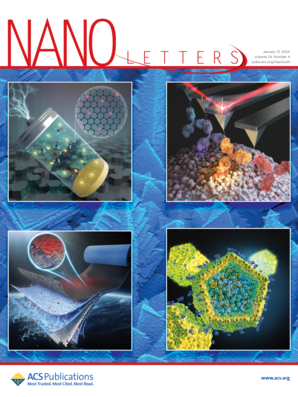Field-Free Current-Induced Magnetization Switching of a Room-Temperature van der Waals Magnet for Neuromorphic Computing
IF 9.6
1区 材料科学
Q1 CHEMISTRY, MULTIDISCIPLINARY
引用次数: 0
Abstract
Spin orbit torque (SOT) has become a promising approach to manipulating magnetization switching. The high-quality interface is essentially desired for SOT performance, which is readily acquired by two-dimensional (2D) van der Waals (vdW) materials. Recently, a 2D ferromagnetic material, Fe3GaTe2, has been discovered to possess an above-room-temperature Curie temperature and strong perpendicular magnetic anisotropy, providing an excellent candidate to build spintronic devices. On the other hand, an external magnetic field is necessary for the SOT-driven deterministic switching, hindering the real applications. Here, we realize field-free SOT switching of Fe3GaTe2 at room temperature. Moreover, inspired by the superiority of 2D materials in 3D heterogeneous integration, we explore the potential in the computing in memory. The artificial synapse function is studied and used in the convolutional neural network, achieving a high-accuracy (∼92.8%) pattern recognition. Our work paves the way for magnetic memory and neuromorphic computing.

用于神经形态计算的室温范德华磁体的无场电流感应磁化开关
自旋轨道转矩(SOT)已成为一种很有前途的控制磁化开关的方法。高质量的界面是SOT性能所必需的,这很容易通过二维(2D)范德华(vdW)材料获得。最近,一种二维铁磁材料Fe3GaTe2被发现具有高于室温的居里温度和强的垂直磁各向异性,为构建自旋电子器件提供了极好的候选材料。另一方面,外部磁场对于sot驱动的确定性开关是必需的,阻碍了实际应用。在这里,我们实现了Fe3GaTe2在室温下的无场SOT开关。此外,受二维材料在三维异构集成中的优势的启发,我们探索了在内存计算中的潜力。研究了人工突触函数并将其应用于卷积神经网络中,实现了高精度(~ 92.8%)的模式识别。我们的工作为磁记忆和神经形态计算铺平了道路。
本文章由计算机程序翻译,如有差异,请以英文原文为准。
求助全文
约1分钟内获得全文
求助全文
来源期刊

Nano Letters
工程技术-材料科学:综合
CiteScore
16.80
自引率
2.80%
发文量
1182
审稿时长
1.4 months
期刊介绍:
Nano Letters serves as a dynamic platform for promptly disseminating original results in fundamental, applied, and emerging research across all facets of nanoscience and nanotechnology. A pivotal criterion for inclusion within Nano Letters is the convergence of at least two different areas or disciplines, ensuring a rich interdisciplinary scope. The journal is dedicated to fostering exploration in diverse areas, including:
- Experimental and theoretical findings on physical, chemical, and biological phenomena at the nanoscale
- Synthesis, characterization, and processing of organic, inorganic, polymer, and hybrid nanomaterials through physical, chemical, and biological methodologies
- Modeling and simulation of synthetic, assembly, and interaction processes
- Realization of integrated nanostructures and nano-engineered devices exhibiting advanced performance
- Applications of nanoscale materials in living and environmental systems
Nano Letters is committed to advancing and showcasing groundbreaking research that intersects various domains, fostering innovation and collaboration in the ever-evolving field of nanoscience and nanotechnology.
 求助内容:
求助内容: 应助结果提醒方式:
应助结果提醒方式:


